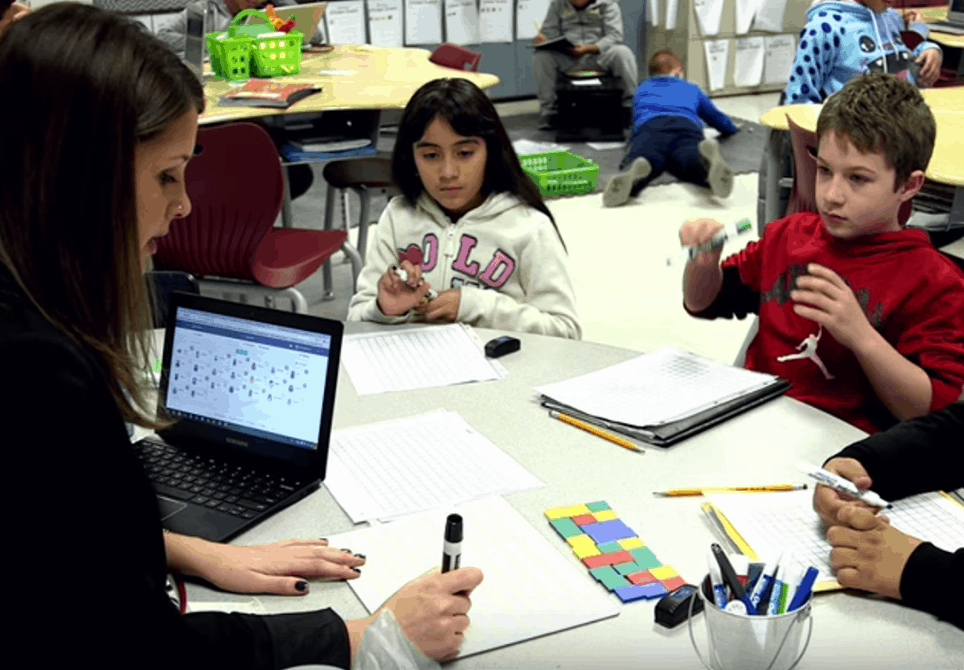‘League of Innovative Schools’ District on Improving Low-Income Student Outcomes

Erica Lawton
The majority of K-12 students in the U.S. now live in poverty, a mark hit in 2013 for the first time in 50 years. For these students, poverty brings a host of other disadvantages, most beyond the school district’s control: broken homes, transient living situations, and a lack of educational support at home. Between 30 and 40 percent of students enter kindergarten not ready for school.
It may seem like the deck is stacked against schools that predominantly educate low-income populations. Once they start their education, those students have a wider variety of social and emotional needs and receive less educational enrichment outside of school. And when those students struggle to catch up academically, they risk falling even further behind their peers.
One district facing that very challenge is Middletown City School District, a member of the Digital Promise League of Innovative Schools. About 70 miles northwest of Manhattan, it’s a place that many families move to from New York City, where effects of poverty are more visible. In Middletown, those effects are more subtle, resulting in, as 6th-grade teacher Brandi Hundley says, “struggling families that are trying to do the best they can — working hard but [without] the privileges that others have.”
More than a decade ago, the district seemed helpless against the educational effects of poverty. About half of its students did not complete high school and all seven of its schools were classified by the state as “in need of improvement.”
To turn things around, Middletown decided to go beyond the school district’s traditional role in addressing poverty, and tackle it head-on. Its ambitious goal is to create learning opportunities that increase outcomes, regardless of family income. Seventy-five percent of its students live in poverty, half are Hispanic, and a quarter are African American.
“We want our kids to have the same opportunities as any other student, regardless of their zip code,” says Eastwood, who is in his 12th year as superintendent.
Much of what Middletown has accomplished can serve as an example for other school districts with similar challenges. A few key takeaways:
Focus on the Whole Student Experience
Middletown works hard to make their students feel welcome by providing opportunities beyond academics, including extracurricular activities, athletics, music, and the building environment. The intent is to let students take part in all that a school offers, which is more than just the academics; it’s also the athletics and the extracurriculars.
Give Students the Opportunity to Succeed at their Own Pace
Eastwood wants each student to be proficient in math and reading before finishing 5th grade. The district is working toward this goal through a wide range of bold initiatives that have been funded by various grants, which include offering two years of kindergarten and ending “social promotion.”
Implement Technology while Supporting and Empowering Teachers
Middletown works to connect every student to technology while equipping teachers with the skills to personalize learning for every student.
The district believes that by providing the same opportunities that those in more affluent communities experience, they will start to see the same outcomes. Even if postsecondary isn’t an immediate option after high school, students still have the ability to pursue alternative educational pathways and career options that are fulfilling and sustaining.
Though the rate of low-income students in Middletown has steadily increased in the last decade, so have graduation rates, to 83 percent in 2014.
The rest of the country is starting to pay attention as well. In 2012, the district was one of 16 U.S. districts to earn a $20 million federal Race to the Top grant. That grant is a large bet that Middletown’s progress is real, and that it will not only continue, but become a model for other districts educating low-income students.
The right investments, a commitment to teachers and its students appear to have a long term return in Middletown.
Excerpted from “Erasing the Look and Feel of Poverty”
For more check out:
- Smart Cities Need Great Schools, The Best Antidote to Poverty
- 3 Tips to Support Project-based Learning for Low-Income Students
- Helping Students Cope With The Trauma Associated With Poverty
Erica Lawton is the Communications Manager at Digital Promise. Follow Erica on Twitter, @EricaLawton,
Stay in-the-know with all things EdTech and innovations in learning by signing up to receive the weekly Smart Update.






Taylor
Two-Year Kindergarten Doesn’t Solve Everything
Low-income students face many different struggles, in and out of the classroom. For the answer on improving education for these students to be hold them back for two year kindergarten and ending “social promotion” is wrong. Holding a student back should be the last resort not the first. Middletown may work hard at providing opportunities in music and athletics, but what about programs on helping students with learning before placing them in two-year Kindergarten?
I do think the idea of giving each student a tablet that allows them to learn at their own pace is a good idea. But what about giving these students the option of this is in regular standard Kindergarten? Some low-income students have the opportunity to attend programs such as Head Start that gets them ready for Kindergarten. When these students participate in Kindergarten screening, they actually might not need this special two-year class. Although they had an opportunity that other low-income students didn’t, that doesn’t mean they should just be pushed along after Kindergarten.
Students learning through technology that works best for them can be great, but at some point they wont have that tool anymore. Most low-income students have a greater chance on not going to college or dropping out of high school. It is important that students can keep up with the curriculum that is required so they have a better chance of exceeding in middle school, and in high school. Improving education in low-income schools shouldn’t just end with tablets or computers being used.